| |
Shrine No. 11 |
last update:
16.10.2008
|
Data
| Shrine No. |
Name /
Transliteration |
Date |
Distance to the Speos of Haremhab
[~ m] |
Remarks |
| 11 |
Senynefer, Hatshepsut,
and others |
Amenophis II |
337 |
|
| |
|
|
|
|
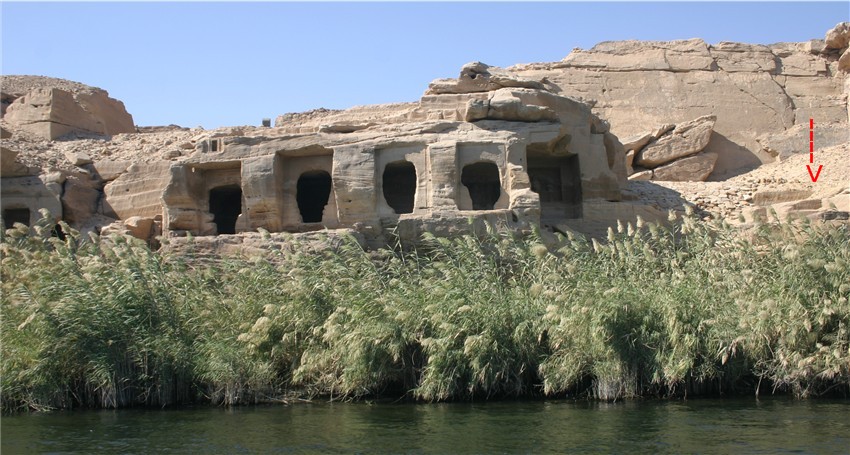
From right to left and side by side the shrines No.: 12 (Minnakhte), 13 (Senyneferi), 14 (Nehesj),
15 (Hapuseneb), 16 (Senenmut), and - destroyed - 17 (User-amun), all built
during the reign of Hatshepsut and Thutmosis III (photo: E. Noppes).
Far right shrine (red arrow) lies shrine No. 11 built during the reign of Amenhotep II.
|
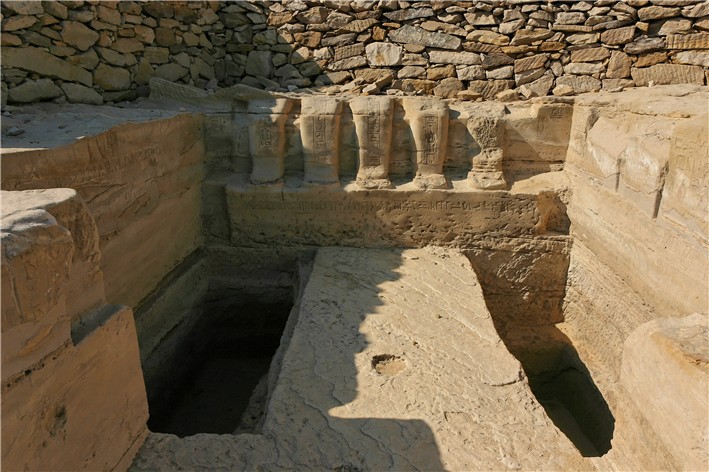
|
Remains of shrine No. 11 seen from the entrance (east side) |
|
Shrine No. 11 is located at the river bank, its entrance drops almost vertically
into the river. It was erected for a certain Senynefer and his wife, Hatshepsut
but finally it had several owners. Both names point to beginning of the 18th
Dynasty, however, are more precise date give the seated statue of User-Satet
which belongs to the row of statues at the rear wall. User-Satet is a well
attested viceroy of Kish (Nubia) under Amenhotep II. |
|
Sometime in antiquity the cliff above the shrine was quarried away and the
shrine leveled down to about half its original height. The facade on the east
side is completely lost except a small part on the southern side of the
entrance. |
|
The shrine consists of 2 rooms, die 1st room (A) behind the entrance is about
186 cm wide and 260 cm deep. The posterior room (B) is about 293 cm at its east
side and a little bit smaller at its west end, about 289 cm. This room is about
251 cm deep. Cut in its west side were five statues seated an a bench. Nothing
but the legs of these statues have survived. |

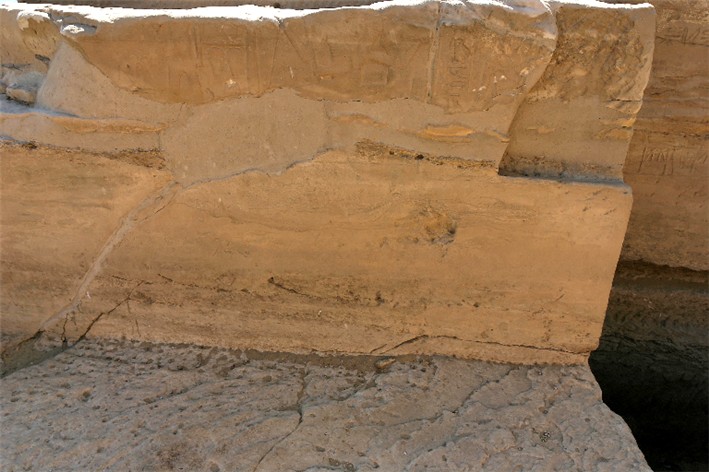
| South wall of the 1st room, at the top a drawing of Caminos,
below an actual photo of the right side of the wall. |
|
Due to the quarrying the 1st room is more or less completely lost. Nothing of
the decoration of the northern wall has been preserved. Although also markedly
destroyed the south wall bears the remnants of the bottom of a scene. The scene
shows a couple seated together in a kiosk and watching several, most likely
agricultural actions in front of them. Perhaps, the scene depicts Senynefer and
his wife. |
|
Also the scenes in the posterior room have been markedly destroyed. Presumably,
the north wall was decorated with 2 registers one above the other but only the
lower one has been largely preserved (see the following drawing taken from Caminos). |
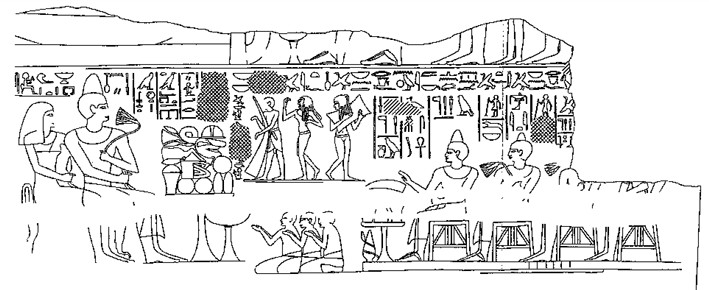
|
The lower register show a banquet. Far left the owner of the shrine, Senynefer,
is depicted and behind him the "Lady of the House", Hatshepsut. Before them
there is a heap of provisions for the feast. Opposite three musicians are
standing, a man plying a harp, in the middle a dancing lady, and finally, a lady
playing a tambourine. Below them three squatting men are shown clapping the
hands to the rhythm of the music. |
|
At the right side of the scene the party guests are shown one after the other.
The 1st one is - according to the inscription - Senynefer's brother, the first
prophet of Khnum, Thutmosis, the next one is a certain Ser[Amun], first prophet
of Haroëris and Sobek, the 3rd one a first prophet of
Nekhbet. |
|
The south wall has also been decorated with scenes arranged in two registers but
not much has been preserved from the upper register (see the following drawing
taken from Caminos). The remains of both
registers obviously presented a funerary feast. The upper register shows far
right the tow seated main figures and before them a table with provisions. Under
the table a pet cat paws a bone. Opposite to the main figures a man is shown
standing followed by four seated guests. |

|
The lower register shows further guests, four on the south wall and two beyond
the corner (south side of the east wall). All guests hold flowers and are seated
on chairs with straight legs, whereas in the upper register the persons are
seated on chairs ending in animal - most likely lion - legs. Obviously, the
guests are watching the ceremonies taking place before them. |
|
The ceremony is guided by a lecture priest who, dressed in the characteristic
leopard-skin, is depicted raising the right hand in a declamatory gesture. In
his left hand he holds a papyrus roll. The accompanying text tells: Making an
offering which the king gives and many beatific spells. Before the lecture
priest three men are shown carrying the offerings: a foreleg of an ox, the heart
of an ox in a dish, and a vase full of water that perhaps should be poured in
dish in front of the kneeling man. |
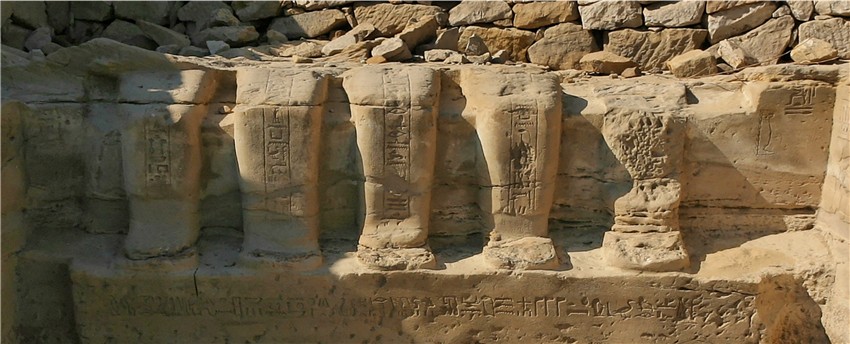
|
Cut into the rear (west) wall were five seated statues (see photo above), of
nothing but he legs have been preserved. The statues are accompanied by partly
destroyed inscription on their legs, on the base, and on the sidewalls. Based on
the inscription on the statues the persons depicted are identified as follows
(from right to left): |
|
Statue 1: the inscription is completely destroyed but most likely, the statue
depicts the wife of Senynefer, Hatshepsut, "Lady of the House" |
|
Statue 2: Senynefer, priest of Amun in the 1st phyle |
|
Statue 3: a "Lady of the House", called
Nn-Hr-mnt-s, known from a statue of User-satet as his mother |
|
Statue 4: User-satet, king's son (= viceroy of Kush), intendant of the southern
foreign countries |
|
Statue 5: a "Lady of the House" called Henettawy, nurse of Amenhotep II (see
also: Roehrig, C.H., 1990) |
|
The inscriptions give no way to establish a relationship between the depicted
persons. Since Senynefer and, most likely, his wife Hatshepsut are presented on
the right side, it may be assumed that on the left User-satet is depicted
together with his wife, Henettawy. Since the mother of User-satet,
Nn-Hr-mnt-s, is presented in the
middle a familiar connection with Senynefer or his wife may also be reasonable. |
|
On both sides of the group of statues a vertical inscription has been carved
into the rock, however, only a few signs have survived. The text on the north
(right) side ends up with: "...[Hat]shepsut, justified". The text on the
south (left) ends with: "...overseer of the king's apartment, Senynefer,
justified." |
On the basis of the statues a vertical inscription repeats on offering formula:
"A boon which the king gives to Osiris, Geb, Nut, and all gods who
are in the pure water, that you may give invocation offerings consisting of
bred, beer, oxen, fowl, libation, wine, and milk in the course of every day to
the spirits of the owners of this shrine, the venerable ones beloved of the
ruler."
|
|






